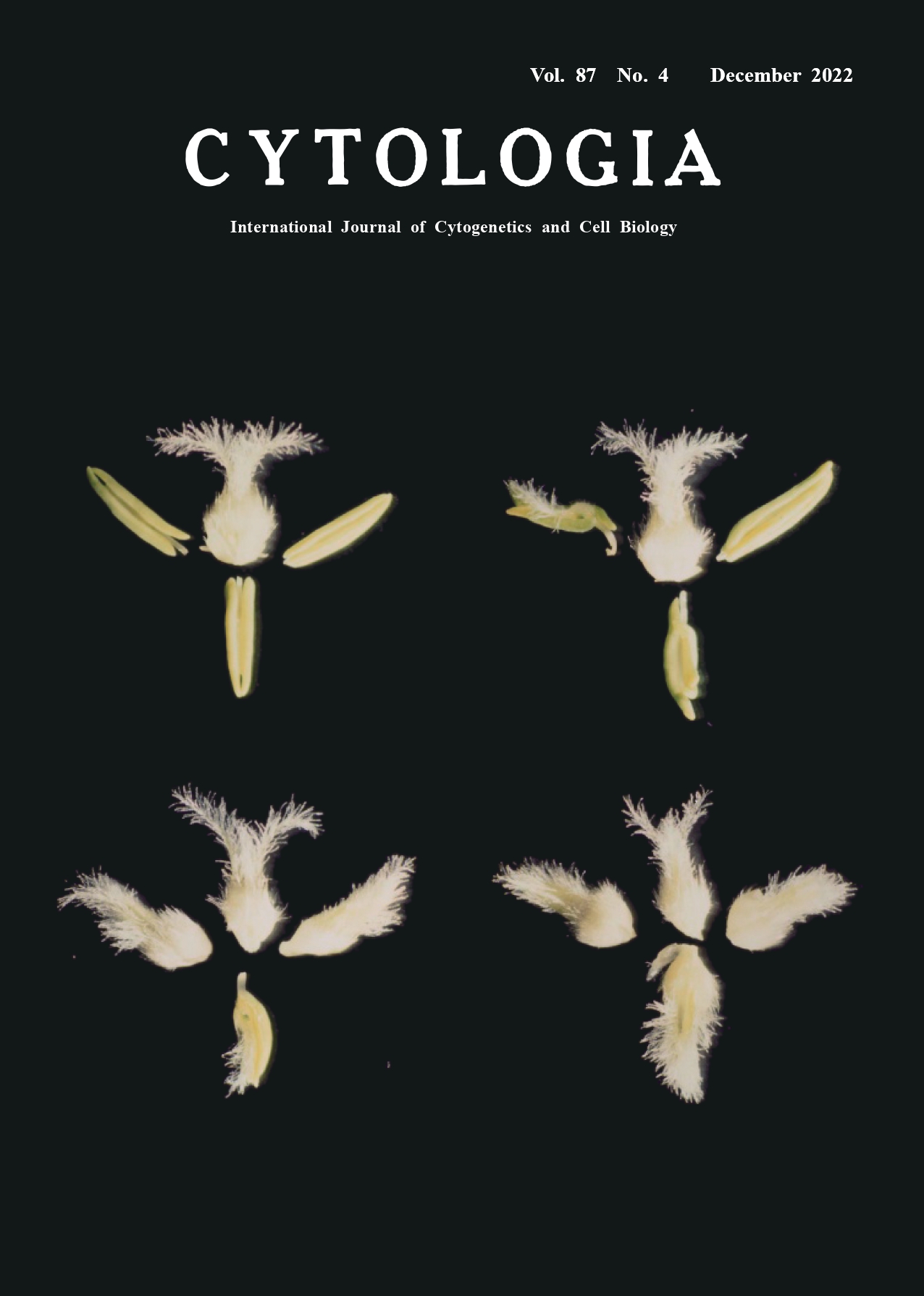| ON THE COVER |  |
||
|---|---|---|---|
| Vol. 87 No.4 December 2022 | |||
| Technical Note | |||
|
|
|||
Pistillody: Homeotic Transformation of Stamens into Pistil-Like Structures in Alloplasmic Wheat Lines Koji Murai* Department of Sustainable Agri-Culture, Awara Campus, Fukui Prefectural University, 88–1 Futaomote, Awara-shi, Fukui 910–4103, Japan
The effects of cytoplasm from wild relatives of common wheat (Triticum aestivum) have been comprehensively investigated using cytoplasmic substitution (alloplasmic) lines (Tsunewaki 2018). Dr. Tsunewaki developed alloplasmic lines of 12 common wheat varieties having cytoplasms of 32 relative species (46 accessions) by recurrent backcrossing: the cytoplasm donors first were crossed as female to cytoplasm recipients, and the hybrids were repeatedly backcrossed with the recipients as the recurrent pollen parents. As the cytoplasm (cytoplasmic genome) was transmitted from only female parent in wheat, the alloplasmic lines have wheat nuclear genome and cytoplasmic genome of the relative species. Among the alloplasmic wheat line correction of Dr. Tsunewaki, we found that an alloplasmic line of Japanese wheat cultivar Norin 26 with Aegilops crassa cytoplasm showed photoperiod-sensitive cytoplasmic male sterility (PCMS) (Murai and Tsunewaki 1993): male fertile under short-day conditions (<12 h light period), while male sterile under long-day conditions (>16 h light period) due to pistillody, the homeotic transformation of stamens into pistil-like structures. In contrast to Norin 26, the wheat cv. Chinese Spring did not show pistillody when Ae. crassa cytoplasm was introduced due to a single dominant Rfd1 gene located on the long arm of chromosome 7B (Murai et al. 2002). PCMS in alloplasmic Norin 26 lines might involve an Rf gene that functions under short-day conditions. We also found that pistillody was caused by altered expression patterns of genes for stamen organogenesis in the alloplasmic wheat (Hama et al. 2004). Furthermore, we identified a pistillody-related mitochondrial gene, which function was suppressed by the nuclear gene Rfd1 (Zhu et al. 2008). The alloplasmic line was sown in October in the experimental field at Fukui Prefectural University. Wheat plants survived the winter in the vegetative growth phase and transited to reproductive growth in the next spring, producing ears and flowering. Floral organs such as stamens and pistils were formed and developed from March to April which day length was 11.5 to 13.5 h. The field conditions in Fukui were neither completely shortday nor completely long-day, so the intermediate types of pistillody was observed. Cover figure show varying degrees of pistillody. In the field conditions of Fukui, the appearance of the pistillody can vary. It is noteworthy that there is an intermediate type of pistillody, in which the stamens are slightly pistillate. This suggests that the pistil is the prototype and the stamen is produced from the pistil.
Hama, E., Takumi, S., Ogihara, Y. and Murai, K. 2004. Pistillody is caused by alterations of the class B MADS box gene expression pattern in alloplasmic wheats. Planta 218: 712–720. Murai, K., Takumi, S., Koga, H. and Ogihara, Y. 2002. Pistillody, homeotic transformation of stamens into pistil-like structures, caused by nuclear-cytoplasm interaction in wheat. Plant J. 29: 169–181. Murai, K. and Tsunewaki, K. 1993. Photoperiod-sensitive cytoplasmic male sterility in wheat with Aegilops crassa cytoplasm. Euphytica 67: 41–48. Tsunewaki, K. 2018. Dawn of modern wheat genetics: The story of the wheat stocks that contributed to the early stage of wheat cytogenetics. Cytologia 83: 351–364. Zhu, Y., Saraike, T., Yamamoto, Y., Hagita, H., Takumi, S. and Murai, K. 2008. orf260cra, a novel mitochondrial gene, is associated with the homeotic transformation of stamens into pistil-like structures (pistillody) in alloplasmic wheat. Plant Cell Physiol. 49: 1723–1733. * Corresponding author, e-mail: murai@fpu.ac.jp DOI: 10.1508/cytologia.87.295 |
|||